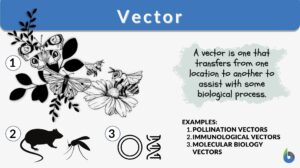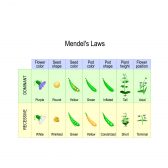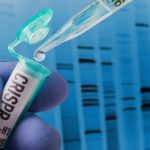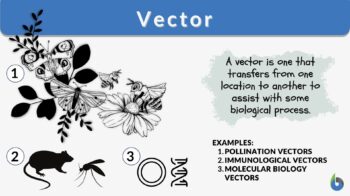
Vector
n., plural: vectors
[ˈvɛktɚ]
Definition: one that transfers from one location to another to assist with some biological process
Table of Contents
Vector Definition
When one thinks of vectors one may think of many different things. This is because a vector can be multiple different things depending on the field it is being used in. In general, the job of a vector is to move or assist with movement. For instance, in mathematics, the meaning of a vector relates to the movement (of something) from one place to another. Figure 1 below shows what a vector in mathematics typically looks like. But what is a vector in other sciences? To define a vector in biology, we would be thinking of something completely different. Its definition varies based on the branch of biology being explored.

Within epidemiology and medicine, a vector refers to a disease vector, which is an organism that carries or transmits infectious diseases. This is considered an infection vector and is noted in the biological branch, immunology. Another type of biological vector is defined as any mode of transport that can be used to bring the DNA sequence that is wanted into a host cell in order for a molecular cloning procedure to occur. Basically, the DNA vector is used to introduce a piece of DNA from one cell to another cell. This is molecular biology vector or vector microbiology.
A nature vector is an organism that helps another by transporting its reproductive structures so that fertilization can occur. These are pollination vectors and are usually called pollinators. All in all, a vector, in biology, is an organism that assists another with some biological process.
A biological vector is an organism that transmits the causative agent or disease-causing organism from the reservoir to the host. It may also refer to a reproductive agent, dispersing reproductive structures, such as a bee that serves as a vector in transmitting pollen to the stigma of a flower. In molecular biology, a vector is an entity that is used to transfer the genetic material, such as a plasmid that is used to transfer DNA sequences from the donor organism to the target cell of the recipient organism. Other examples of molecular vectors are binary vectors, cloning vectors, shuttle vectors, viral vectors, and expression vectors. Etymology: Latin, from “vehere”, meaning “carrier“.
Synonyms:
- carrier (epidemiology)
- intermediate host (epidemiology)
- pollinator (botany)
Types of Vectors
There are many different types of vectors in biology as seen in the definitions above. These vectors can also be classified into subsets of vectors as follows:
Immunology vectors
A disease vector is an organism that transmits infectious diseases from one organism to another. This can occur through the vector transmitting the disease to the organism or contracting the disease from an organism and then passing it on. These diseases can cause major outbreaks that lead to severe illnesses and even death in some cases. There are two (2) major types of disease vectors:
- Arthropod vectors – Arthropod vectors are mainly insect vectors that transmit disease through their blood-feeding abilities at all or some points in their life cycles. This will occur when the arthropod directly injects the virus or parasite into the bloodstreams of the organism they are feeding on. Parasites also get into the host’s body when the arthropod vector chews through the skin.
- Rodent vectors – Rodent vectors have become the main transmitters of over sixty (60) different zoonotic diseases. These typically smaller, warm-blooded creatures transmit the diseases through their dung droppings, saliva, urine, and even their fur. This usually occurs through the rodents eating, meddling with, or excreting on food or other objects humans may also consume or touch. In rare cases, the rodent may also directly bite the human and transmit disease.
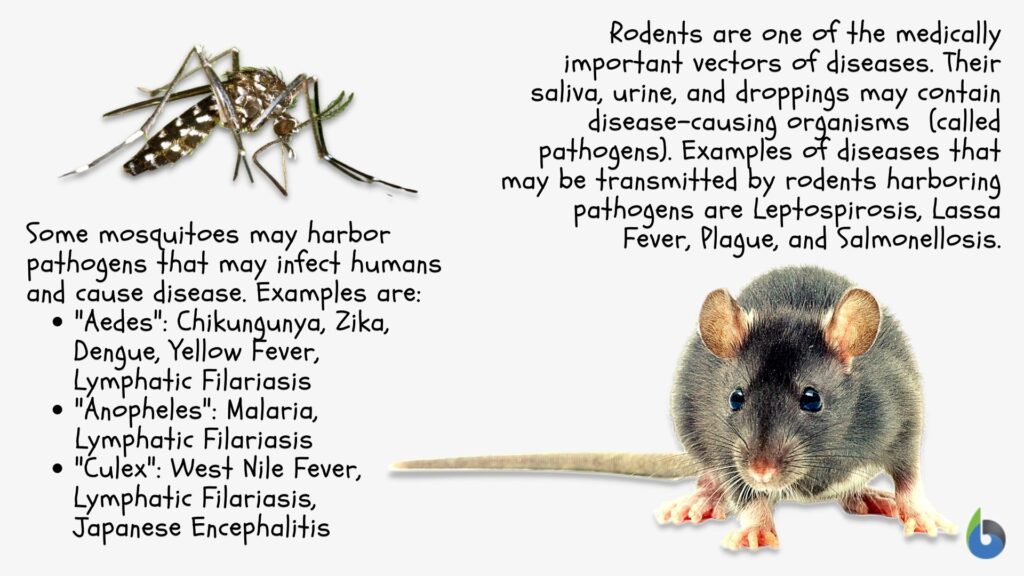
Molecular biology vectors
In micro and molecular biology, a vector is a method of transportation or it may serve as an agent that transports a piece of genetic material into a cell or organism. There are four (4) major types of molecular vectors, each helping with a different sector of the duplication process:
- Cloning vector – Cloning vectors can replicate on their own and so are often used for replication of recombinant DNA. Their main job is to decipher and decide which cells are the best for replicating certain segments of DNA. They have very diverse and unique features and are quite different from the other types of molecular vectors. These can be plasmid vector, cosmid, bacteriophage vector, bacterial vector, human vector, or yeast vector artificial chromosome.
- Viral vector – These vectors are used to effectively transfer genetic material into a host in order to modify its cells or tissue. This will allow for the manipulation of these cells and tissues so that they may be used to express genes differently. Viruses becoming vectors are quite useful as they are efficient in getting their own genetic material into that of the host.
- Expression vector – Expression vectors are the vectors that allow cloned genes to be expressed so that one can tell if the cloning process was successfully done or not. They are very necessary to the duplication process as the cloning vector cannot express genes, so the expression vectors are needed to ensure that everything went smoothly. There are specialized expression vectors such as secretion vectors that express cloned genes so that proteins can be made in other areas besides the cytoplasm of the cell.
- Shuttle vector– These vectors do just what their name implies as they transport or “shuttle” origins of replications between two different hosts. Shuttle vectors can contain DNA sequences from both mammalian and bacterial cells, making them hybrid vectors. They usually contain DNA plasmids that are replicable in both mammalian and bacterial cells.
Watch the vid below to learn more about plasmid vectors.
Pollination vectors
These biological vectors are those that transport the reproductive structure of plants from one plant to another in order for pollination to occur. These vectors can be biotic or abiotic.
- Biotic – biotic pollination vectors are animals that transport pollen grains (male reproductive part) from one flower to the stigma or female reproductive part of the same or a different flower on the same plant or a completes different plant (cross-pollination). This occurs when the pollen grains stick to the feet, feathers, or mouths of the animal and then come off when they rest on the same or a different flower.
- Abiotic – abiotic pollination vectors are those non-living things that can also act as pollinators by taking the pollen grains of one flower and transporting them to the stigma of another flower of the same flower on the same or a different plant. They usually do this cross-pollination using the elements or some other method in the abiotic environment.
Watch the vid below to learn the importance of biological vectors involved in pollination.
Vector Examples
Let us learn further and see more examples of biology vectors.
Immunology vector examples
There are numerous types of arthropod vectors and they are all hematophagous, which means they feed on blood. Probably the most common type of arthropod vector is the mosquito. There are three (3) kinds of mosquito vectors that transmit multiple kinds of diseases. They are Aedes, Anopheles, and Culex. These mosquitoes may carry parasitic, viral, or both types of pathogens (organisms causing diseases). Figure 4 below shows all three types of mosquitoes. Aedes aegypti is the mosquito species that is the most prevalent vector for the viral disease, dengue fever. The parasitic infection malaria, in turn, is one of the major causes of death in children under the age of five (5) and is transmitted by the Anopheles mosquito. Other arthropod vectors include aquatic snails, blackflies, fleas, lice, sandflies, ticks, triatome bugs, and tsetse flies.
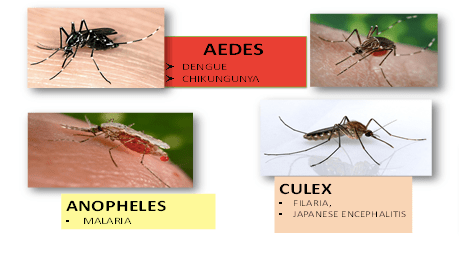
Rodent vectors also cause a lot of trauma and tribulations are they too spread many detrimental infectious diseases. Rats and mice are the most common examples of disease vectors. These rodent vector pairs transmit over 35 vector-borne diseases. Mice and rats (along with other rodent vectors) were the main cause of the bubonic plague otherwise known as the black death of medieval Europe and caused millions of death in that era. The bubonic plague along with other diseases such as salmonellosis and leptospirosis plague our world today. Other rodent vectors include squirrels, guinea pigs, rabbits, and hammers among other rodents.
Molecular biology vectors
Molecular biology vectors are usually given specific names. For instance, the pBR322 is a biological vector example plasmid. The pBR322 is a plasmid cloning vector that is often used when working with prokaryotes like E.coli. This particular microbiological vector was designed to replace two others that had malfunctioned in their functions and so they were unable to perform at their optimum as a vector. The pBR322 had a remodeled structure in which the aim was to fit as many restriction enzyme cleavage sites as possible while ensuring the vector stayed as small as possible. Initially, the pBR322 was created to ensure that E.coli and other similar prokaryotes could be cloned efficiently through the vectors technology. However, now the vector insert has been developed into products that can now assist with the cloning of specific functions and organisms.
Pollination vectors
The biological vectors’ main duty is to assist with the pollination process by cross-pollination. They bring the male reproductive parts of the flower to the female reproductive parts so that fertilization of the flower can occur. Prime examples of biotic pollination vectors are birds, bats, bees, mosquitoes, and many other types of insects and small mammals since these either feed on the flowers or are attracted to them because of their colorful nature.
The honey bee is the most well-known bee in the world though they are not the most abundant bee species. Bees are ones of the most commonly known pollinators in the ecosystem and are generally not as aggressive and harmful as people think. Bees possess tiny hairs on their legs and back that often act like velcro in which pollen grains can stick to them. These bees then collect and transfer pollen grains from flower to flower as they collect nectar to bring back to their hives to feed other bees and make honey.
Abiotic vectors for pollination are those non-living things that also act as vectors and transport pollen grains to the female reproductive parts of the flower so that fertilization can occur. These can include elements like water, wind, and rain. For instance, wind can blow the pollen grains from one flower onto the stigma of another and complete cross-pollination. This can be clearly seen in the Figure below.

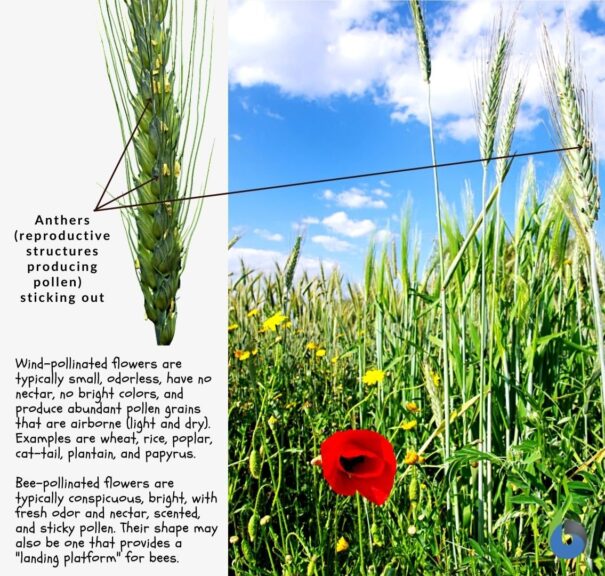
Try to answer the quiz below to check what you have learned so far about vectors.
References
- Boundless. (2021). Arthropods as Vectors. Biology Libretexts. https://bio.libretexts.org/Bookshelves/Microbiology/Book%3A_Microbiology_(Boundless)/8%3A_Microbial_Evolution_Phylogeny_and_Diversity/8.20%3A_Helminths/8.20D%3A_Arthropods_as_Vectors
- Center for Disease Control. (2021). Diseases carried by Vectors. U.S Department of Health and Sciences. https://www.cdc.gov/climateandhealth/effects/vectors.htm
- Morand, S., Jittapalapong, S., & Kosoy, M. (2015). Rodents as hosts of infectious diseases: biological and ecological characteristics. Vector-borne and zoonotic diseases (Larchmont, N.Y.), 15(1), 1–2. https://doi.org/10.1089/vbz.2015.15.1.intro
- Sapkota, A. (2021). Vector – Definition, Features, Types, Examples, Applications, Limitations. Microbe Notes. https://microbenotes.com/vector-molecular-biology/
- National Human Genome Research Institution. (2021). Vector. About Genomics. https://www.genome.gov/genetics-glossary/Vector
- Truly Nolen. (2014). Rats and Mice as vectors of Disease. True Nolen of America. https://www.trulynolen.com/pest-expert-tips/rats-and-mice-as-vectors-of-diseases
- U.S Forest Service. (2021). What is Pollination? U.S Department of Agriculture. https://www.fs.fed.us/wildflowers/pollinators/What_is_Pollination/
- WHO. (2021). Vector-borne diseases. World Health Organization. https://www.who.int/news-room/fact-sheets/detail/vector-borne-diseases
©BiologyOnline.com. Content provided and moderated by Biology Online Editors.

